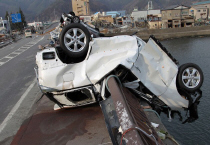
Typical street scene in Santa Ana, El Salvador. (Photo: iStock)
IMF Survey: Asia Likely to Suffer Economic Repercussions From Japan Earthquake
April 28, 2011
- Earthquake to have major impact on industrial production in Japan
- Spillovers to Asian economies through global supply chain
- Despite accelerating growth in 2012, downside risks remain large
The earthquake and tsunami which devastated much of Japan’s north east coastal region earlier this year will affect economic activity not only in Japan, but also other Asian countries over the coming months, predicts the IMF.

The impact of Japan’s earthquake and tsunami is likely to be felt well outside its geographic boarders, says the IMF (photo: Koichi Kamoshida/ZUMA Press/Corbis)
THE JAPAN DISASTER
In an analysis of the likely effects of the disaster, IMF economists suggest industrial production will be particularly hard hit in Japan, with a likely ripple effect across productive sectors through the supply chain.
“The impact of Japan’s natural disaster is also likely to be felt well outside its geographic borders, mainly through trade channels … however, a stronger impact could be felt on the supply side,” says the report.
Disruptions in global supply chain
The economists suggest prolonged disruptions to production in Japan could affect other economies along the global supply chain, particularly in those industries where Japan provides a large share of global supply such as in the production of silicon wafers for microchips.
Asia’s economies are highly integrated through cross-border production networks, and Japan remains the second most important source of imported intermediate inputs in the region. It accounts for about 10-15 percent of the value added produced in some Asian economies, including Malaysia, Thailand, and Taiwan Province of China.
In the short term, the report predicts that firms could use existing inventories and then, over time there could also be a switch to alternative suppliers. “Although Japan’s status as a highly specialized supplier of electronic components and capital goods suggests limits to this strategy,” say the economists.
Comparisons with Kobe
The report draws comparisons with the Kobe earthquake of January 1995 when industrial production declined by 3 percent in the first month after the earthquake, but rebounded quickly before reaching pre-quake levels within one quarter.
“Reconstruction led to an investment boom and, as employment rose and confidence strengthened, retail sales began to rise again after one quarter.”
Following the Kobe disaster, GDP growth picked up from 0.9 percent the previous year to 1.9 percent for the whole of 1995.
But the report points out a number of critical differences between the Kobe earthquake and the more recent disaster, including the scale of the two events—initial estimates of damage to infrastructure from the more recent earthquake are about twice as large as those caused by the Kobe quake.
The area affected by electricity supply interruptions is also much larger notes the report, and includes the entire Kanto region around Tokyo, which accounts for around 40 percent of GDP.
“Restoration of capacity is likely to take longer this time, due to severe damage to thermal and nuclear power plants and to key component suppliers in the area, especially in electronic and automobiles, implying possibly greater supply disruptions in the production chain than after the Kobe earthquake,” says the report.
Envisaging a rebound
The IMF economists have revised downwards their growth predictions for Japan in 2011 from 1.6 percent to 1.4 percent. They expect private domestic demand to decline 1 percentage point as a result of the severe damage to capital and electricity supply.
But growth is expected to be lifted by a stronger contribution from the public sector, in particular through a series of fiscal packages (estimated at 0.8 percent of GDP) which is to be targeted at infrastructure investment.
In 2012, growth is projected to accelerate to 2.1 percent off the back of reconstruction efforts.
But the report also highlights the significant downside risks to the outlook. In particular, lingering uncertainties surrounding the nuclear issue and the interruption of power generation which it says could delay the recovery by disrupting production across the country and weigh on sentiment.
“In this case, policies to repair damaged infrastructure and promote reconstruction would play an important role in addressing the uncertainties and supporting the recovery.”







